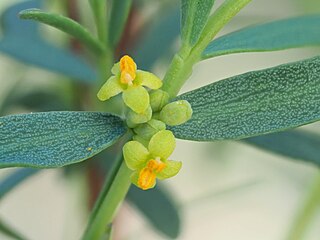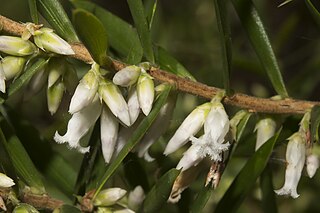
Scaevola aemula, commonly known as the fairy fan-flower or common fan-flower, is a species of flowering plant in the family Goodeniaceae. It has mostly egg-shaped leaves and blue, mauve or white fan-shaped flowers. It grows in New South Wales, South Australia and Victoria.

Lobelia purpurascens, commonly known as white root or purplish pratia, is a flowering plant in the family Campanulaceae of eastern Australia. It is a small herbaceous, scrambling plant with white to pale pink flowers.

Cyrtostylis reniformis, commonly known as common gnat-orchid, is a species of orchid endemic to eastern Australia. It usually has a single kidney-shaped leaf and a flowering spike with up to eight reddish flowers with a shelf-like labellum.

Westringia dampieri, commonly known as shore westringia, is a flowering plant in the family Lamiaceae, it grows in South Australia and Western Australia. It is a small, dense shrub with white, mauve, cream or purple flowers.

Chloanthes is a genus of four species of flowering plants in the family Lamiaceae and is endemic to Australia. Plants in this genus are shrubs with hairy foliage, blistered or wrinkly leaves and flowers with five petals fused at the base, usually with two "lips".

Pimelea pauciflora, commonly known as poison rice-flower, is a species of shrub in the family Thymelaeaceae. It has small yellow-lime flowers and green, smooth fleshy leaves, and is endemic to Eastern Australia.

Haemodorum spicatum is a plant in the Haemodoraceae family native to south Western Australia.

Ptilothrix deusta is a sedge in the family Cyperaceae found in south eastern Australia. It is commonly seen in wet sandy soils in heathland, growing from 30 to 60 cm tall. This is one of the many plants first published by Robert Brown with the type known as "(J.) v.v." appearing in his Prodromus Florae Novae Hollandiae et Insulae Van Diemen in 1810 as Carpha deusta. It was transferred to the genus, Ptilothrix, in 1994 by Karen Wilson. The genus name is derived from ancient Greek, meaning feather hair. The specific epithet deusta is derived from the Latin with a meaning of burnt.

Epacris sparsa, is a small upright shrub with creamy-white flowers, elliptic to egg-shaped leaves and reddish new growth. It is endemic to New South Wales with a restricted distribution.

Leucopogon gracilis is a species of flowering plant in the heath family Ericaceae and is endemic to the south of Western Australia. It is a spindly shrub with wiry branchlets, linear to lance-shaped leaves, and dense spikes of white or pinkish flowers.

Samolus junceus in the family Primulaceae is a species of water pimpernel native to Western Australia.

Scaevola striata, commonly known as royal robe, is a species of flowering plant in the family Goodeniaceae. It has blue fan-shaped flowers, and is endemic to Western Australia.
Chloanthes glandulosa is a species of flowering plant in the family Lamiaceae. It is a small shrub with wrinkled leaves and greenish-yellow tubular flowers. It is endemic to New South Wales.

Dampiera incana, commonly known as the hoary dampiera, is a flowering plant in the family Goodeniaceae and is endemic to Western Australia. It is a perennial herb with grey foliage and blue-purple flowers.

Styphelia propinqua is a species of flowering plant in the heath family Ericaceae and is endemic to the south-west of Western Australia. It is an erect, rigid shrub with linear leaves and white tube-shaped flowers that are bearded inside.

Lechenaultia tubiflora, commonly known as heath leschenaultia, is a species of flowering plant in the family Goodeniaceae and is endemic to the south-west of Western Australia. It is a hemispherical subshrub or more or less erect perennial with crowded, narrow, rigid leaves and variably-coloured, tube-shaped flowers.

Leucopogon collinus, commonly known as fringed beard-heath, is a species of flowering plant in the heath family Ericaceae and is endemic to south-eastern Australia. It is a slender, erect or spreading shrub with narrowly lance-shaped leaves, and white, tube-shaped, bearded flowers.

Epacris paludosa, commonly known as swamp heath, is a species of flowering plant from the heath family, Ericaceae, and is endemic to eastern Australia. It is an erect, bushy shrub with lance-shaped, elliptic or egg-shaped leaves and tube-shaped white or cream-coloured flowers in crowded, leafy heads at the ends of branches.

Styphelia deformis is a species of flowering plant in the heath family Ericaceae and is endemic to eastern coastal Australia. It is a bushy shrub with narrowly egg-shaped leaves, and white, tube-shaped flowers.
Styphelia prostrata is a species of flowering plant in the heath family Ericaceae and is endemic to the south-west of Western Australia. It is a low, spreading or prostrate shrub with linear leaves and red, tube-shaped flowers that are bearded inside.

















